Light Rail Transit (Singapore)
The Light Rapid Transit, or Light Rail Transit (LRT), is a series of localised automated guideway transit systems acting as feeder services to the heavy rail Mass Rapid Transit, which together forms the core of Singapore's rail transport services. The first LRT line was opened in 1999 and the system has since expanded to three lines, each serving a public housing estate, namely Bukit Panjang LRT line, Sengkang LRT line and Punggol LRT line. Trains on these lines have at least one station linking it to the MRT and in turn the remainder of the LRT network.
 | |
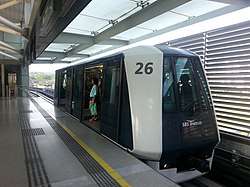 A SBS Transit Mitsubishi Crystal C810 train at Punggol MRT/LRT station. | |
| Overview | |
|---|---|
| Native name | Sistem Rel Ringan (Malay) 轻轨列车系统 (Chinese) இலகு கடவு ரயில் (Tamil) |
| Owner | Land Transport Authority |
| Locale | Singapore |
| Transit type | Automated guideway transit/People mover (APM) |
| Number of lines | 3 |
| Number of stations | 41 (excluding Teck Lee) |
| Daily ridership | 180,000 (2016)[1] |
| Operation | |
| Began operation | 6 November 1999 |
| Operator(s) | SBS Transit Ltd (ComfortDelGro Corporation) SMRT Trains Ltd (SMRT Corporation) |
| Number of vehicles | 89 trainsets (19 on order, 19 to be decommissioned) |
| Technical | |
| System length | 28.6 km (17.77 mi) |
| Track gauge | No conventional rail track |

In the conventional definition of LRT, it refers to an upgraded form of tram that uses articulated low-floor tram cars and partial grade separation; in some cases such as Kuala Lumpur and the Docklands Light Railway, LRT refers to a medium-capacity rail-based light metro system. Unlike the aforementioned examples, Singapore's LRT system uses rubber-tired automated guideway transit trains that are more comparable to those found in airport people mover systems. [2]
Along with the MRT, the LRT is constructed and owned by the Land Transport Authority, with operating concessions currently handed to SMRT Trains Ltd and SBS Transit Ltd. With the completion of Singapore's three LRT lines, there are no plans to further expand the LRT network in the future.[3][4]
History
Conception
In September 1991, the Urban Redevelopment Authority (URA) unveiled the revised Concept Plan 1991, which proposed a new mode of feeder rail that could serve new towns such as Yishun and Tampines. Such systems were to be fully automated and elevated light rail systems to serve as faster alternatives to existing feeder buses. [5]
In 1994, then Communications Minister Mah Bow Tan tasked the Mass Rapid Transit Corporation (MRTC) to study the use of an LRT in Singapore, particularly as an internal feeder service for new towns. In particular, two towns, Bukit Panjang and Sengkang, were to be studied for the feasibility of the LRT. MRTC also commissioned British consultant, Oscar Faber TPA, to conduct a feasibility study for an LRT system in the Beach Road/Nicoll Highway corridor in anticipation of the increased demand for transport services in the area due to several major developments such as Suntec City, Marina Centre and Shenton Way. On 3 December that year, Mah announced the government’s intentions to pilot two LRT systems at Bukit Panjang and Buona Vista. New LRT systems were also suggested for more mature towns such as Toa Payoh although further decisions were only to be made after the pilot programmes were conducted. [5] Eventually, the proposed LRT around Buona Vista was cancelled due to insufficient demand for the rail line.[5][6]
In 1995, study trips were made to the SK and Véhicule Automatique Léger (VAL) systems in France to study on the feasibility of building LRT systems near HDB public flats and integration of the LRT with other public transport modes as well as the H-Bahn suspended monorail system in Germany to study into the possibility of implementing such a system for Singapore Polytechnic and the National University of Singapore. [5]
In 1996, the Land Transport Authority (LTA), which was formed from the merger of several transport statutory boards including MRTC in 1995, published a White Paper which outlined its goals for a world-class transport system in Singapore, one of which was the utilisation of LRT systems as feeder services to the MRT network, and the integration of LRT facilities with HDB estates to maximise convenience for residents. [5]
In addition to using the LRT system as feeder service, the government also studied into the feasibility of using it to connect neighbouring towns with one another, such as Bedok-Tampines, Ang Mo Kio-Bishan-Toa Payoh, and the Jurong areas. [5]
Punggol LRT line North Branch
A North Branch consisting of two to four LRT stations for the Punggol LRT line had been planned, which would have brought commuters from Punggol LRT station via Sam Kee and Teck Lee LRT station before branching out from the West Loop tracks onto this branch, terminating near Coney Island. The branch was never built, but only visible in the planning stages of Punggol LRT since 2000.[7]
The North Branch was therefore replaced by Punggol Coast MRT station and the bus interchange in 2013[8] which better serve future residents in the area.
Jurong LRT line
A Jurong LRT line was also proposed in 2001 which would have served the planning areas of Jurong, Boon Lay, Choa Chu Kang, and the future Tengah town. However, the LTA announced in 2008 that there were no plans to develop it.[9] Nonetheless, the LTA later revived the line as the Jurong Region MRT line in the Land Transport Master Plan 2013, and it is set to open in stages from 2026 to 2028.[10][11]
Opening of lines
The Bukit Panjang LRT line opened on 6 November 1999, with all 14 stations opening at the same time. Ten Mile Junction LRT Station was closed from 10 December 2010 till 30 December 2011 for retrofitting works due to the closure and redevelopment of Ten Mile Junction shopping mall (now known as Junction 10), making it the first MRT/LRT station to be completely closed in Singapore after opening. It is the first and only LRT line to be operated by SMRT Light Rail.
The Sengkang LRT line opened in two main stages, the East Loop opening first on 18 January 2003 and most of the West Loop on 29 January 2005. Farmway LRT station on the West Loop subsequently opened on 15 November 2007. On 1 January 2013, Cheng Lim LRT station opened for passenger service and the west loop now operated in both directions.[12] The last station on the line to be opened, Kupang opened for passenger service on 27 June 2015.[13]
For the Punggol LRT line, the East Loop started operating on the same day as the Sengkang LRT's West Loop, with two stations closed. Oasis LRT station was opened for service on 15 June 2007, after more residents moved into HDB flats in the station's vicinity.[14] Damai LRT station opened on 20 June 2011.[15] The West Loop opened on 29 June 2014 at 11.15 am, with Nibong, Sumang and Soo Teck being the first stations to open.[16] Sam Kee, Punggol Point and Samudera opened on 29 February 2016, 29 December 2016 and 31 March 2017 respectively.[17][18] Teck Lee LRT station will remain closed until the area around the station has been developed.[17]
Improvements
Sengkang-Punggol LRT improvements
On 31 October 2012, LTA announced that by 2016, Sengkang and Punggol LRT systems will be upgraded to a two-car system for 16 of the 41 existing train cars, allowing double the number of passengers to board at any one time. Each train car can take up to 105 passengers. Hence, there is also the need to modify the signaling and communication system.[19]
On 22 December 2015, the two-car trains entered service on the Sengkang LRT line, boosting capacity to 204 per trip as compared to 105 in a single car configuration.[20]
As of 2017, two car trains have entered service on the Punggol LRT line.[17]
On 15 December 2017, the Land Transport Authority said there will be limited services on parts of the Sengkang-Punggol LRT (SPLRT) on most Sundays from 14 January 2018 to 25 February 2018, to facilitate renewal and improvement works from (except 18 February as it is a Chinese New Year holiday). Only one platform will open for service at 5.30am on Sundays. The other platform will open from 7am.[21][22][23] The arrangement is expected to continue until 29 April 2018.[24][25]
On 14 February 2018, the LTA announced that it has taken over SBS Transit's rail assets (the North East MRT line and Sengkang-Punggol LRT lines) worth $30.8 million and transit to the New Rail Financing Framework on 1 April 2018.[26] The LTA has also said that this will benefit commuters as there will be "more coordinated and timely expansion, and renewal of the rail system".[27]
From 27 May 2018 to 7 October 2018, limited services on Sundays will continue on the Sengkang-Punggol LRT (SPLRT). One platform will open at 5.30am and the other platform will open at 5.30pm.[28][29]
Bukit Panjang LRT improvements
For the Bukit Panjang LRT line, SMRT and LTA announced plans to completely overhaul the BPLRT system as the system is reaching its lifespan of 20 years.[30] Transport Minister Khaw Boon Wan has also announced plans to shut the Bukit Panjang LRT down for a small number of years to pave the way for the system's overhaul.[31] On 23 October 2017, SMRT announced that the Bukit Panjang Light Rail Transit (BPLRT) system will begin operations at 7 am, instead of 5.30am, on all Sundays from 12 November 2017 until the end of the year, to allow more time for works to improve service reliability.[32]
On 23 March 2018, SMRT said that the Bukit Panjang LRT line will be closed on 11 Sundays from 15 April 2018 to 24 June 2018 as part of maintenance works aimed to improve the reliability of the beleaguered system.[33][34]
On 21 June 2018, SMRT said from 1 July 2018 to 28 October 2018, all BPLRT stations will open on Sundays at 8am, instead of the usual 5.30am.[35][36][37]
On 12 January 2019, Ten Mile Junction served its last passengers and closed on the next day, 13 January 2019. It also marks the end of Service C on the Bukit Panjang LRT.
Infrastructure
Network
| Line and livery | Opening year | Terminal | Stations | Length (km) | Depot | Electrification | |
|---|---|---|---|---|---|---|---|
| SMRT Light Rail | |||||||
| Bukit Panjang LRT | 1999 | Choa Chu Kang | 13 | 7.6 | Ten Mile Junction Depot | AC 3-Phase 600 V | |
| SBS Transit | |||||||
| Sengkang LRT | 2003 | Sengkang (East Loop) | 5 | 10.7 | Sengkang Depot | DC 750 V | |
| 2005 | Sengkang (West Loop) | 8 | |||||
| Punggol LRT | 2005 | Punggol (East Loop) | 7 | 10.3 | |||
| 2014 | Punggol (West Loop) | 6a | |||||
|
a – excluding Teck Lee which is not operational. | |||||||
| Total: | 41 | 28.6 | |||||
Facilities
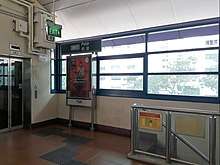

Since the LRT system was built in the 1990s, plans for barrier-free facilities have already been included during the planning stages. All 43 stations are equipped with such facilities, thus there will be no difficulties present for the old and handicapped. Barrier-free facilities include lifts, ramps, a tactile guidance system and wider faregates. These barrier-free facilities will be included in all future LRT stations.[38]
Lines
Bukit Panjang LRT (BPLRT)
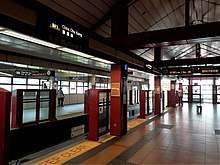
The Bukit Panjang LRT Line (BPLRT) is the first light rail line in Singapore. Spanning 7.6 km and consisting of 13 stations, the entire line opened in 1999 and is the first and only LRT line to be operated by SMRT Trains.[39]
Sengkang LRT (SKLRT)
The Sengkang LRT (SKLRT) is a 10.7 km light rail line which partially opened on 18 January 2003. It is part of the LRT system together with the other two lines. The East Loop has 5 stations, all operational, from Compassvale to Ranggung whereas the West Loop has 8 stations from Cheng Lim to Renjong. On 27 June 2015, Kupang opened, making it the last station on the Sengkang LRT to be opened. The completion of several new residential developments in the area deemed it suitable to operate after 12 years.[40]
Punggol LRT (PGLRT)
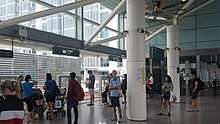
The Punggol LRT (PGLRT) is a light rail line in Singapore within the LRT system together with the other two lines. Its first phase, which comprises a 10.3 km light rail line with 15 stations, began operating on 29 January 2005 (with the exception of Oasis, which was opened on 15 June 2007 and Damai, which was opened on 20 June 2011) whereas Nibong, Sumang and Soo Teck were opened on 29 June 2014, the rest of the stations are not opened as Punggol was halfway developed. Subsequently, Sam Kee opened on 29 February 2016, Punggol Point opened on 29 December 2016 while Samudera opened on 31 March 2017 as the area around the stations became more developed. Teck Lee will be opening in tandem with the developments around the area.
Rolling stock
| Line | Name | No. of Trains |
Service Start | Speed Limit |
|---|---|---|---|---|
| Bukit Panjang LRT | Bombardier Innovia C801 | 19 | 1999 | 48 km/h |
| Bombardier Innovia C801A | 13 | 2014 | ||
| Sengkang-Punggol LRT | Mitsubishi Crystal Mover C810 | 41 | 2003 | 70 km/h |
| Mitsubishi Crystal Mover C810A | 16 | 2016 | ||
The trains on the LRT system are fitted with rubber tyres, rather than steel wheels, on specially-constructed guideways from which its power is also sourced. All cars are fully automated and driverless, and are controlled from their respective depots.
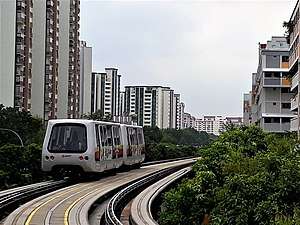 A Bombardier INNOVIA APM 100 running on the guiderails, in the new SMRT livery.
A Bombardier INNOVIA APM 100 running on the guiderails, in the new SMRT livery.- A Crystal Mover on the Punggol LRT system at Punggol LRT station.
Signalling
All lines are able to run automatically, are fully driverless and automated. The following list documents the systems:
| Line | Supplier | Solution | Type [note 1] | Commissioning | Length (km) | Level of Automation[note 2] | Control Centre | Remarks |
|---|---|---|---|---|---|---|---|---|
| Bukit Panjang LRT | Bombardier | CITYFLO 550[41][42] | Fixed Block | 1999 | 7.8 | UTO | Ten Mile Junction Depot | |
| Sengkang LRT | Kyosan | APM Signalling[43] | 2003/2005 | 10.7 | Sengkang Depot | |||
| Punggol LRT | 2005/2014 | 10.3 |
Depots
The LRT system consists of two depots, which run the maintenance, inspection, train overhaul facilities, and house the cars overnight. The Ten Mile Junction Depot houses cars for Bukit Panjang LRT, and the Sengkang Depot houses cars for the Sengkang LRT and Punggol LRT, together with the North East Line of the Mass Rapid Transit (MRT).
Fares and ticketing
The Light Rail Transit uses the same ticketing system as the Mass Rapid Transit. It uses the contactless EZ-Link smart card and a standard single trip ticket.
Instead of using turnstile faregates, all stations on the Bukit Panjang LRT Line now use retractable faregates instead which is faster and easier and the replacement was completed in 2017.
Safety
By 2018, glass and steel platform barriers were installed at all 43 LRT stations to prevent people from falling onto the tracks. Unlike the ones in overground MRT stations, the LRT structures will not have sliding doors but fixed openings. The barriers have been erected at Choa Chu Kang and Bukit Panjang LRT stations in anticipation of higher commuter traffic with the opening of Downtown Line 2. This will be followed by the rest of the stations on the Bukit Panjang and Sengkang-Punggol LRT lines by 2018.[44]
The installation of these barriers was completed at all LRT stations in 2017.[45]
See also
Notes
- Fixed Block = Fixed Block signalling. Moving Block TBTC = Moving Block using Induction Loops. Moving Block CBTC = Moving Block Using Radio.
- UTO = Unattended Train Operation. DTO = Driverless Train Operation. STO = Semi-automated Operation Mode
References
- "Bus, rail ridership soars to new high". Retrieved 22 April 2017.
- "台南市社區大學 新加坡閱讀參訪之旅: 4-2 交通運輸 文/蘇昭旭". Retrieved 26 October 2019.
- "A Journey into Singapore MRT's past". Remember Singapore. 23 July 2013. Retrieved 2 October 2019.
- "15 Interesting Facts About The MRT You Probably Didn't Know". GoodyFeed. Retrieved 25 February 2020.
- "Infopedia: First Light Rail Transit System". Retrieved 26 October 2019.
- Toh, Elgin (2 October 2017). "Of LRT disruptions and political pressure". The Straits Times. Retrieved 20 May 2019.
- "Mitsubishi Heavy Industries Crystal Mover". Mitsubishi Heavy Industries America, Inc. Retrieved 27 May 2019.
- "LTA 2040 Land Transport Master Plan" (PDF). Land Transport Authority. Retrieved 27 May 2019.
- "No Plans To Develop Jurong LRT For Now". Land Transport Authority. 26 May 2008.
- "TWO NEW RAIL LINES AND THREE NEW EXTENSIONS TO EXPAND RAIL NETWORK BY 2030". Land Transport Authority. 17 January 2013. Archived from the original on 6 July 2014.
- "Jurong Region Line to serve NTU, Tengah estate, Jurong Industrial Estate". Channel NewsAsia. Retrieved 21 March 2019.
- "Cheng Lim LRT Station To Open And Sengkang West LRT to Run in Both Directions". SBS Transit. 21 December 2012.
- "Kupang LRT Station to open on Saturday, 27 June 2015" (PDF). SBS Transit. 15 June 2015.
- "Opening Of Oasis LRT Station". SBS Transit. June 2007. Retrieved 12 October 2013.
- "SBS Transit Opens Woodleigh and Damai Stations". SBS Transit. 8 March 2011. Retrieved 12 October 2013.
- "Punggol West LRT System to Commence Passenger Service and North East Line to Add More Train Trips". SBS Transit. 18 June 2014. Retrieved 29 June 2014.
- "Commencement of Two-Car Operations on Punggol LRT East Loop & Opening of Punggol Point LRT Station on 29 December 2016". SBS Transit. 29 December 2016. Retrieved 4 January 2017.
- "Sam Kee Station on Punggol LRT System to open for Passenger Services". SBS Transit. 18 February 2016. Retrieved 4 January 2017.
- "2-car System for Sengkang Punggol LRT by 2016; Improvements to Choa Chu Kang LRT Station". Land Transport Authority. 31 October 2012. Archived from the original on 22 October 2013. Retrieved 12 October 2013.
- "2-car trains roll out on Sengkang LRT". Straits Times. 24 December 2015. Retrieved 31 December 2015.
- "Limited Sengkang-Punggol LRT services on Sunday mornings from Jan to Feb". 15 December 2017.
- "Limited Sengkang-Punggol LRT services on Sunday mornings from Jan 14". 15 December 2017.
- "Limited service along Sengkang-Punggol LRT on Sundays in Jan, Feb to facilitate rail works". channelnewsasia.com. 15 December 2017.
- "Maintenance work to resume on Sengkang and Punggol LRT systems on Mar 4". channelnewsasia.com.
- hermesauto (22 February 2018). "Maintenance works to resume on Sengkang and Punggol LRT systems". straitstimes.com.
- "North-East Line, Sengkang and Punggol LRTs to move to new financing framework". channelnewsasia. 14 February 2018.
- Abdullah, Zhaki (15 February 2018). "LTA to take over SBS Transit rail assets worth $30.8m". straitstimes.
- hermesauto (11 May 2018). "SBS Transit extends limited service on Sundays for Sengkang, Punggol LRT to October". straitstimes.com.
- "Limited service hours on Sundays for Sengkang-Punggol LRT to be extended". todayonline.com.
- "SMRT reveals options to overhaul ageing Bukit Panjang LRT System". Retrieved 24 October 2017.
- "Govt may shut down Bukit Panjang LRT for at least 3 years: Khaw Boon Wan". The Independent. Retrieved 24 October 2017.
- Cheng, Kenneth (23 October 2017). "BPLRT to start running later on Sundays from Nov 12 for renewal works". TODAY Online.
- hermesauto (23 March 2018). "Bukit Panjang LRT to close for 11 Sundays for maintenance works starting April 15". Retrieved 8 April 2018.
- "Reliability on Bukit Panjang LRT to 'improve significantly', but works won't solve bumpiness issues". Retrieved 8 April 2018.
- https://www.channelnewsasia.com/news/singapore/bukit-panjang-lrt-sundays-late-opening-10454556
- https://www.straitstimes.com/singapore/transport/bukit-panjang-lrt-to-resume-sunday-operations-in-july-but-with-later-opening
- https://www.todayonline.com/singapore/bukit-panjang-lrt-resume-operations-sunday-july-1-later-opening-time
- "FACILITIES PROVIDED FOR PEOPLE WITH DISABILITIES IN MRT/LRT STATIONS" (PDF). Building and Construction Authority (BCA). Retrieved 1 November 2012.
- "About SMRT: Business and Subsidiaries". Retrieved 4 November 2017.
- "Kupang LRT Station to Open and More than 260 Weekly Trips to be Added to the Sengkang/Punggol LRT". 15 June 2015.
- "Mass transit signalling". Bombardier Transportation. Archived from the original on 16 June 2020. Retrieved 16 June 2020.
- "Bombardier Projects in Mass-transit signalling" (PDF). Retrieved 16 June 2020.
- "Kyosan Corporate Report 2018". p. 19 to 20. Archived from the original on 16 June 2020. Retrieved 16 June 2020.
- "Platform barriers at all LRT stations by 2018 to prevent falls". Straits Times. Retrieved 24 November 2015.
- "Safety barriers installed on Bukit Panjang LRT; to be completed on Sengkang-Punggol LRT next year". 3 October 2017. Retrieved 24 October 2017.
External links
| Wikimedia Commons has media related to: |
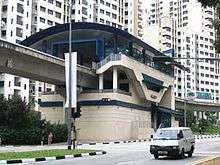
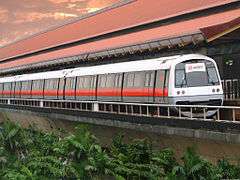
.jpg)